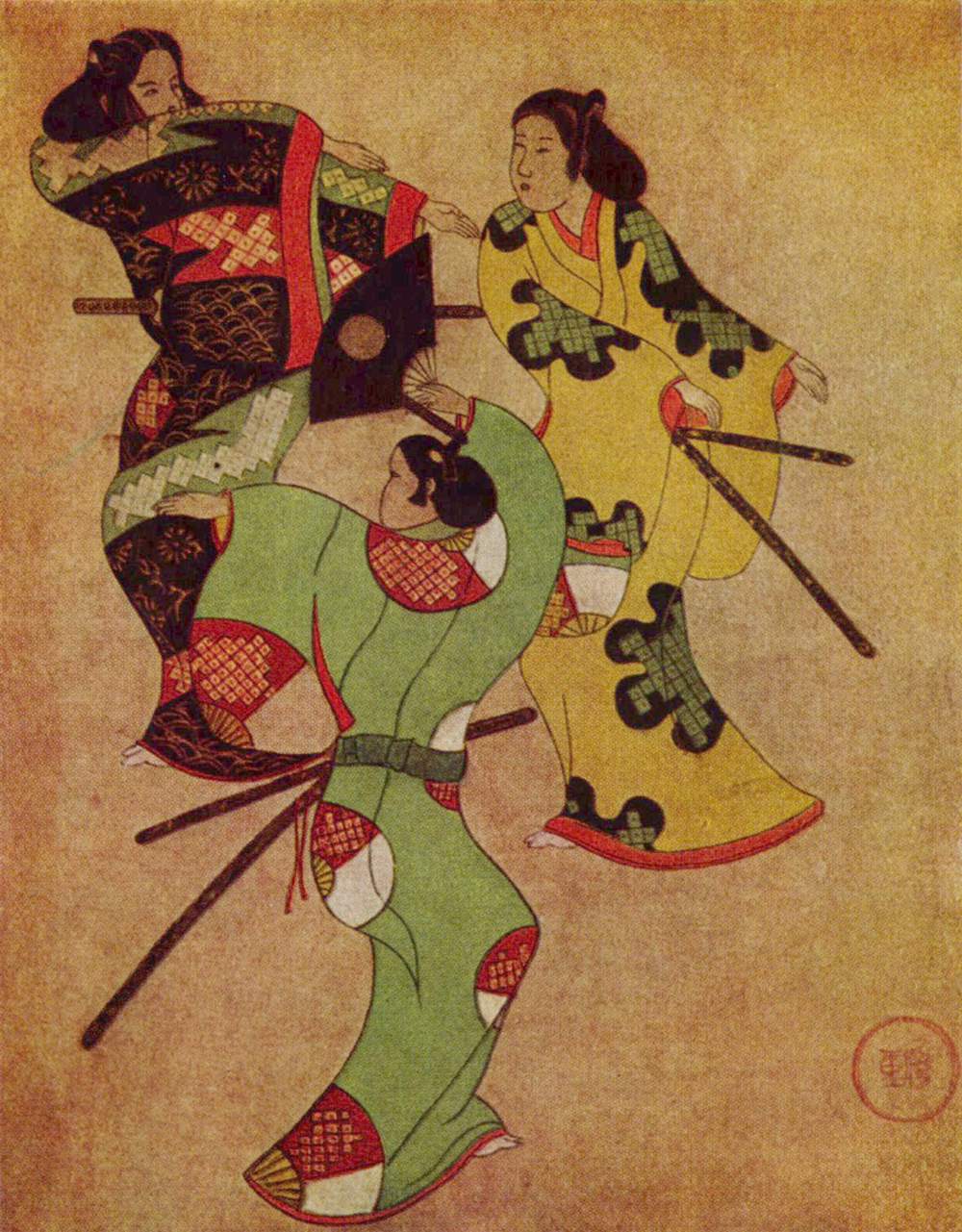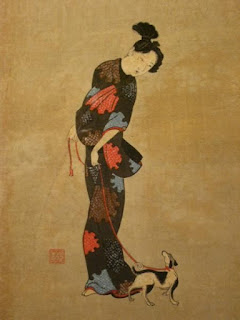This essay will explore the art motif known in Japanese art as Tagasode Byobu ( Whose sleeves Screen | 誰袖屏風 ) This motif is a recurring art form which was particularly popular during the Azuchi-Momoyama era ( 安土桃山時代 | 1568-1600 ) as a representation of the ways in which Buddhist sensibilities met with the fast changing events of the end of the Sengoku Jidai (1467-1615) and as an extension of the habit of wealthy women from military families came to own and store a large number of Kimono.[1] Prior to this, Kin Byobu ( Golden Screens | 金屏風 ) for the most part depicted nature like Sesshuu Touyou (1420-1506) after Chinese Cha'an painter Muxi ( 牧谿 | c.1210-1269 ) or 'flower-and-bird' scenes like those of Kano Eitoku (1543-1590), rather than humans or human paraphernalia as an extension of the Zen painting school of thought about materialism.[2][3]
Tagasode as a folding screen motif specifically refers to the reoccurring appearance of Kosode who belong to a mystery owner on their Byobu. Most of these are often draped across Ikou ( Clothing Stand | 衣桁 ) used to display the entirety of a trendy and wealthy womans Kimono. A number of these stands whilst decorative can also be important in the telling of the composition of the piece, being made of Bamboo or Ebony Lacquer, and often spread out in the Byobu.[1] This spread out composition is part of Zen Buddhism aesthetic thought that we should treat ourselves as one with the natural world rather than seperate.
The lack of human figures in Tagasode Byobu comes from the Japanese understanding of Buddhist art. The human in Japanese art at this point was heavily limited to portrayals of appropriate depictions of religious and powerful figures of mostly classical, mythical and pious affiliation.[2] Their owner is therefore not present, and instead the onus is on the viewer to assume certain things about the owner in the viewers own mind, rather than stating a definitive version of the owner. This is were the split of European and Japanese aesthetical composition comes into play, as the Occidental or European framework to these Byobu may often be egological, rather than following the Zen teaching of 'Not-Two'.[4][5] Some in the Nezu musuem though do depict human figures, but this is abnormal.[8]
'Tagasode' originates from the phrase:
色よりも - 香こそあはれと - おもほゆれ - 誰が袖ふれし - 宿の梅ぞも
Iro yorimo - ka koso aware to - omohoyure - tagasode fureshi - yado no ume zomo
More colour - Than perfume - Primarily - Whose sleeves hang - In the plum tree at the inn [6]
This phrase comes from the Kokin Wakashuu ( Ancient & Modern Waka Poetry | 古今和歌集) which was written in 905 CE. The poem refers to the hanging sleeves of an absent woman, who often holds the connotation of being especially beautiful and thus is missed. The poem evokes this idea by pointing to the presence of her lingering colourful hanging sleeves, and wafting perfume from the Ikou which evokes her absence.[6] It is these lingering elements which the viewer is supposed to piece together to remind them of the beautiful woman who owns them.[7]
Between 1100-1400, wealthy women increasingly had a larger number of Kimono. As such, rules began to made about the best way to organise, store and present these Kimono. Ikou as such then became popular and standard wardrobe accessories by the 1500s, and images of these or Ikou-Ga ( Clothing Stand Pictures | 衣桁画) also became part of wealthy household decor, which would have stood alongside literal Ikou to showcase all of a wealthy womens', particularly bridal, Kimono. These stands were used to showcase Kosode in the Onna Shorei Shuu ( Womens' Etiquette Anthology | 女諸礼集 | 1660 ) which shows Bridal Kosode with the Ikou arrangement in the Fukinuki yatai ( Blown-off Roof | 吹抜屋台) Yamato-e diagonal perspective style.
By the Jokyo era (1684-1688), the Tagasode Byobu rarely appeared as the Ikou Byobu ( Clothing Stand Screen | 衣桁屏風 ) which was a conventional item in a womens wedding ceremony. This was illustrated in accordion Sumizuri-E Etiquette Encyclopedias for women between 1687-1750. Tayuu and some Yujo had begun to also have Tagasode painted for them as a tradition handed down from military wives of the Sengoku Jidai (c1570) who used Tagasode as way of exerting their influence, much as the Chonin now did to expand their own market appeal.[1]
By the 18th century however, Tagasode Byobu were owned or created by art connoisseurs who wished to reflect back on Japanese art, and Byobu will often at times have Inception Byobu as there are Screens painted on Screens with Tagasode slumped over them. This reflected their owners refined taste, art knowledge and also their wealth to have owned these classical Japanese masterpieces. Tagasode continued over onto lacquerware, Kosode and Kimono into the Meiji period. About 40 examples (from c.1550-1725) were known to exist in 2009, with the term being a recognised term as a genre of Byobu since around 1911.
Kyoto and the Machi-Eshi
A majority of the Tagasode Byobu were created by wealthy elites for other wealthy elites. Kyoto was the largeest site of production for Tagasode, and these were created or requested by the wealthy wives of Daimyou or Kuge who had the money to gold-leaf everything. Due to their cost, a large number of Kin-Byobu were made as wedding gifts and may have served to reduce the expense of buying and producing the garments depicted instead. Byobu could be used indoors to create space and dimension to a room, or to tell a story. Some screens were also used outside during parties.[1]
Their creators are mostly Anonymous Machi-Eshi ( Town Painters | 町絵師 ) who migrated away from the court to places like Sakai after their separation from established patronage from the Imperial court, Shogunate and Temples during the Sengoku Jidai.[1][10] Early painters followed the lead set by Eitoku, and their pupils like Hasegawa Touhaku ( 長谷川 等伯 | 1539-1610 ) the founder of the Rinpa School created the atmosphere at court and at large to recieve Kin Byobu as Wamono. These then became presumably sought after items by women who used literature to connect their worldly belongings to Buddhist aesthetical philosophy, requesting Town Painters like Tawaraya Sōtatsu (c.1570-1640) or their apprentices to paint the Tagasode Byobu.[10]
Phases of popularity
Milhaupt describes how there are 3 historical periods of the Tagasode Byobu, the First being the Bamboo Stand group, made presumably during the Momoyama period (1573-1615) in which a Bamboo stand will be present. The Second being the Instrument group, made presumably during the Matabei era (1625-1650) in which musical instruments are present alongside lacquer Ikou. The Third group being the Profuse group, made later on (1650-1725) in which a larger number of Kosode are present on the Ikou racks than in the other 2 groups.[1] The Profuse Group often uses more items to give a sense of depth than the Bamboo or Instrument Group, and their reason to exist was usually more so to focus on their owners 'taste' rather than just their wealth.
Kosode were depicted on Byobu for numerous reasons. The initial use of Tagasode Byobu would have been for wealthier military wives to showcase their vast number of Kimono in wealth displays to their social peers who would've visited their homes during the Sengoku Jidai in a way to both flaunt their wealth and their ability to power project unto other visiting Daimyou that their own fiefs vast wealth could afford to provide such luxurious accommodations to the lady of the land in wartime. These are for the most part Milhaupt's Bamboo Group.
See http://burkecollection.org/catalogue/221-tagasode-whose-sleeves for Instrument Group
See https://www.bonhams.com/auctions/24858/lot/2076/ for Profuse Group
Later Byobu would have been more likely a trend followed by Tayuu and Yujo in their copying of these wealthy women's interior decorating tips, to showcase their own value and to peacock, as the Instrument Group. This is seen to have trickled down to some wealthy Chonin patrons who also had their own Tagasode Byobu made for their wives weddings. Some Tagasode were also used as a way for Chonin to sell Kosode in their stores, to promote the work of their Kimono weavers as well in a kind of late 17th century Chonin promotional sales tactic.[1] The later Tagasode Byobu which are extant and fall into a greater appreciative Wamono phase in Japanese art under Sakoku which see a revitalisation and appreciation of 'Japanese' art, and thus revisits a lot of the first 2 groups, being the Profuse group which operates under the Iki phase the Genroku era was then undergoing.[11]
Contextually, we can see how Tagasode Byobu developed from an initial need to exhibit soft-power in the face of hard power for the wives of the military elites of the Sengoku Jidai. This later became a motif which was adopted and born from the patronage of the Machi-Eshi to wealthy ladies, primarily in Kyoto who used these to display their ongoing soft-power in the forthcoming era of Stabilisation Policy pushed by the Tokugawa authorities. This trickled down by the early Edo period, to the Chonin who adopted Tagasode due to its high art status and used it as a way to advertise their own businesses, much like the soft-power projection of Sengoku military wives. By the Kambun era, this reflected the Ikou-ga Byobu of the Muromachi period once more as the country was in peacetime, and this was continued when Inception Tagasode became the popular norm by the 18th century when Tagasode reflected the Machi-Eshi painter tradition of depicting the Tagasode motif.
Present existing examples currently reside in the Idmitsu Museum of Arts (出光美術館蔵 ), the Nezu Museum (根津美術館蔵), Suntory Museum of Arts (サントリー美術館), Sen-Oku Hakukokan (泉屋博) Museum in Japan and the Metropolitan Museum of Art and the Burke Collection in the West. These existing works hold particular interest to those interested in the Momoyama and Early Edo period, as they tell us about the popular or at the least what the wealthy were wearing and how they wished to present themselves in their Kosode such as fans, stripes and florals. Tagasode thus in context reveal when new techniques and trends may have been created or popularised again amongst the wealthy and also show us how their owners used Kosode and Tagasode to exhibit wealth, their artistic merits, to attract clients and how to project power into the world around them and to their social circles.
For more examples, see:
http://burkecollection.org/catalogue/221-tagasode-whose-sleeves (c.1600)
https://artgallery.yale.edu/collections/objects/109899 (c.1600)
https://www.artsy.net/artwork/japanese-edo-period-whose-sleeves-tagasode-painting-with-waves-of-matsushima-screen (c.1700)
Bibliography
[1] Interiors Imagined: Folding Screens, Garments, and Clothing Stands, Terry Satsuki Milhaupt, 2009, metmuseum.org (Accessed 27/11/2021) | https://www.metmuseum.org/toah/hd/fold/hd_fold.htm
[2] See Bijin #1
[3] Japanese Kinbyobu: The Gold Leafed Folding Screens of the Muromachi Period (1333-1573) P. II-IV, Bettina Klein, Carolyn Wheelwright, 1984, Vol. 45, pp.101-102, Artibus Asiae Publishers
[4] https://en.wiktionary.org/wiki/egology
[5] See Japanese Zen Buddhist Philosophy, '5.3 Zen’s Meaning of Not Two', Anonymous, 2006[2019], Stanford Encyclopedia of Philosophy (Accessed 27/11/2021) | https://plato.stanford.edu/entries/japanese-zen/
[6] http://www.aisf.or.jp/~jaanus/deta/t/tagasode.htm
[7] https://patrons.org.es/kyoto-capital-of-artistic-imagination/
[8] https://www.japantimes.co.jp/culture/2014/11/06/arts/openings-in-tokyo/tagasode-screens-kimono-painting-theme/
[9] http://www.aisf.or.jp/~jaanus/deta/m/machieshi.htm
[10] https://artgallery.yale.edu/collections/objects/109899
[11] See 'Iki' in Glossary & 'Sumptuary Laws (1604-1685)' in Bijin #3
Social Links
One stop Link shop: https://linktr.ee/Kaguyaschest
https://www.etsy.com/uk/shop/KaguyasChest?ref=seller-platform-mcnav or https://www.instagram.com/kaguyaschest/ or https://www.youtube.com/channel/UC5APstTPbC9IExwar3ViTZw https://www.pinterest.co.uk/LuckyMangaka/hrh-kit-of-the-suke/
.jpg)


_MET_DT1618.jpg)
.jpg)




